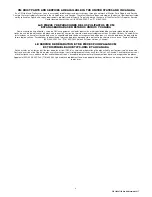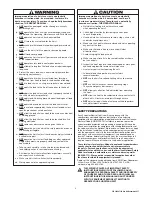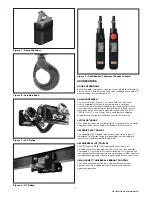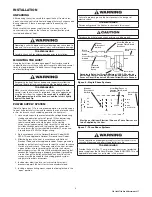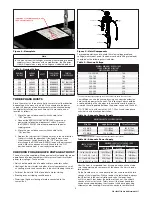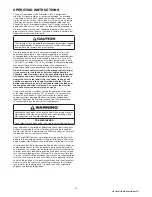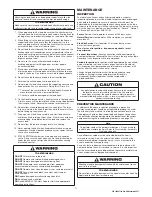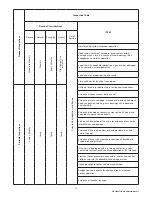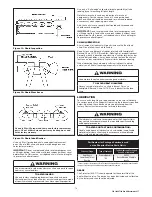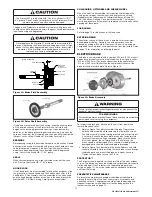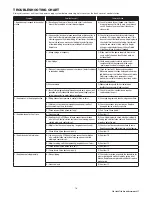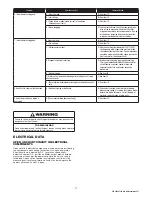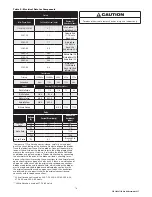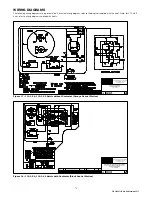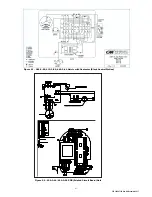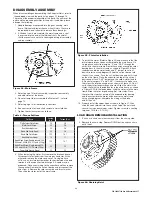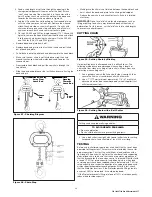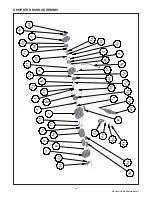
11
P/N 192047138 Rev AA November 2017
Attaching the load hook to an inadequate support may allow the
hoist and load to fall and cause injury and/or property damage.
TO AVOID INJURY:
Make sure the structure and the load hook attachment point have
sufficient strength to hold several times the hoist and rated load.
1. When preparing to lift a load, be sure that the attachments to
the load hook are firmly seated in hook saddle. Avoid off center
loading of any kind, especially loading on the point of the hook.
2. When lifting, raise the load only enough to clear the floor or
support and check to be sure that the attachments to the
hook and load are firmly seated. Continue lift only after you are
assured the load is free of all obstructions.
3. Do not load the hoist beyond the rated capacity shown on the
brake end cover. Overloading can cause immediate failure of
some load-carrying part or create a defect causing subsequent
failure at less than rated capacity. When in doubt, use the next
larger capacity of hoist.
4. Do not use this or any other overhead materials
handling equipment for lifting persons or allow people
on unsecured load.
5. Stand clear of all loads and avoid moving a load over heads
of other personnel. Warn personnel of your intention to move
a load in their area. Do not leave unsecured load over people.
6. Do not leave the load suspended in the air unattended.
7. Permit only qualified personnel to operate unit.
8. Do not wrap the load chain around the supporting structure and
hook onto itself as a choker chain. Doing this will result in:
1. The loss of the swivel effect of the load hook which could
mean twisted chain and a jammed liftwheel.
2. The chain could be damaged at the load hook.
9. On the Double-reeved hoists, check for twists in the load chain.
A twist can occur if the lower block has been capsized between
the strands of chain. Reverse the capsize to remove twist.
10. Do not allow a load to bear against the hook latch. The latch
is to help maintain the hook in position while the chain is slack
before taking up the slack chain.
11. Take up a slack load chain carefully and start load easily to
avoid shock and jerking of hoist chain. If there is any evidence
of overloading, immediately lower the load and remove the
excess load.
12. Do not allow the load to swing or twist while hoisting.
13. Never operate the hoist when flammable materials or vapors
are present. Electrical devices produce arcs or sparks that can
cause a fire or explosion.
14. STAY ALERT! Watch what you are doing and use common
sense. Do not use the hoist when you are tired, distracted or
under the influence of drugs, alcohol or medication causing
diminished control.
TO AVOID INJURY:
DO NOT
Lift more than rated load.
DO NOT
Operate with twisted, kinked or damaged chain.
DO NOT
Operate damaged or malfunctioning hoist
DO NOT
Lift people, loads over people, allow people on
unsecured load or leave unsecured load over people.
DO NOT
Operate hoist when load hook is not centered overhoist.
DO NOT
Permit load hook block to contact hoist frame or
chain container.
DO
Replace damaged or malfunctioning hook latch.
DO
Keep load chain well oiled.
DO
Read ASME B30.16 Safety Code for Hoist and appropriate
operating instructions.
MAINTENANCE
INSPECTION
To maintain continuous and satisfactory operation, a regular
inspection procedure must be initiated to replace worn or damaged
parts before they become unsafe. Inspection intervals must be
determined by the individual application and are based on the type
of service to which the hoist will be subjected. The type of service to
which the hoist is subjected can be classified as “Severe”, “Normal”,
or “Stand by Service” per ANSI E1.6-2.
Severe
Service: Hoist operates in excess of 200 days a year.
Normal Service:
Hoist operates 200 or fewer days a year but
more than 25.
Stand by Service
: Hoist operates 25 or fewer days per year
but at least once per year.
Two classes of inspection - frequent and periodic – must
be performed.
Frequent Inspections:
Visual examination shall be performed by
a competent person following the items listed in the inspection table
Records of such inspections are recommended.
Periodic Inspections:
Inspection shall be performed by a qualified
person following the items listed in inspection table. Records of
this inspection shall be recorded and retained for a minimum of 36
months after the hoist is taken out of service.
Lifting and lowering functions shall be tested under no-load
conditions. (Testing through complete rated lift length is
not required). Brake(s) operation shall be tested under
no-load conditions.
Any deficiencies found during inspections are to be corrected
before the hoist is returned to service. Also, the external
conditions may show the need for disassembly to permit a
more detailed inspection, which, in turn, may require the use of
nondestructive type testing.
PREVENTIVE MAINTENANCE
In addition to the above inspection procedure, a preventive
maintenance program should be established to prolong the useful
life of the hoist and maintain its reliability and continued safe use.
The program should include the periodic and frequent inspections
with particular attention being paid to the lubrication of the various
components using the recommended lubricants (see page 15).
Note
To perform some of the periodic inspections, it is necessary to
partially disassemble the hoist. Refer to Disassembly - Assembly
starting on page 23.
Any deficiencies noted must be corrected before the hoist is
returned to service. Also, the external conditions may show the
need for more detailed inspection which, in turn, may require the
use of nondestructive-type testing.
Any parts that are deemed unserviceable are to be replaced with
new parts before the unit is returned to service. It is very important
that the unserviceable parts be destroyed to prevent possible future
use as a repair item and properly disposed of.
Allowing a load to bear against the hook latch and/or hook tip can
result in loss of load.
TO AVOID INJURY:
Do not allow a load to bear against the hook latch and/or hook tip.
Apply load to hook bowl or saddle only


